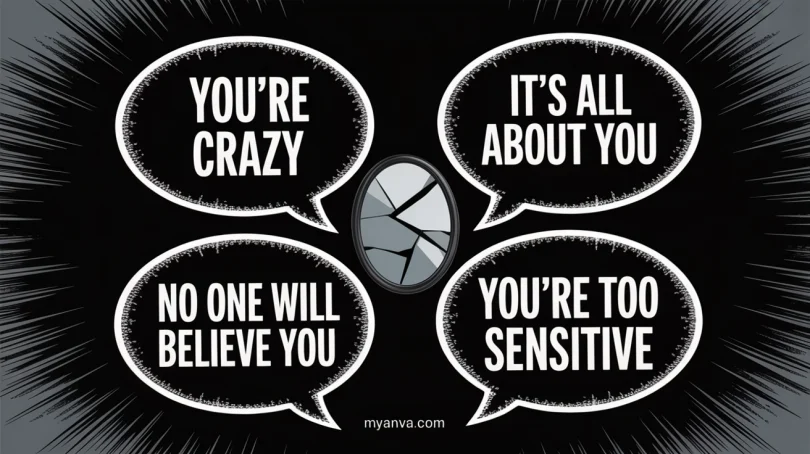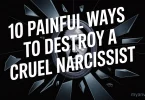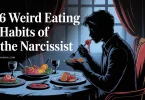Narcissistic relationships produce profound emotional wounds, programming the individual to see himself and engage with the world in a specific way. Driving these dynamics is the narcissist’s requirement to preserve an illusion of greatness and perfection.
When a vulnerable veil is breached, as is often the case by another person’s natural emotional reaction, the narcissist will refuse to apologize. Instead, they might call the person manipulative, invalidate his feelings, and deflect blame elsewhere.
This article explores the experiences of those in narcissistic relationships, the effects of gaslighting, and the complex journey toward healing. Through the story of one woman’s lifelong encounters with narcissistic abuse, we’ll examine how these dynamics manifest, how they distort self-perception, and why societal misunderstanding often compounds the pain.
A Lifelong Pattern of Narcissistic Abuse
Consider the story of a woman who grew up in a narcissistic family system. One parent was narcissistic, often heralded as the family hero for their outward contributions, while the other, more loving parent, was consumed with appeasing their narcissistic counterpart. This left the woman feeling emotionally abandoned, though she couldn’t articulate it as a child.
She idealized the loving parent as a coping mechanism, protecting herself from the chaos of her environment. It wasn’t until adulthood that she began to unpack the dual reality: her loving parent was also a victim of narcissistic abuse, rendering them emotionally unavailable.
As a child, this woman was empathetic, perceptive, gentle, and introspective, yet she never felt fully safe. She was largely overregulated and self-controlled, but occasionally, overwhelming anger would erupt in what she described as “meltdowns.” These rare outbursts led to labels like “intense” or “angry,” both at home and school. The family even turned her emotional struggles into a running joke, despite her not being an inherently angry person.
Related Topics:
Breaking Free from Narcissistic Abuse: Five Crucial Steps
What is Narcissistic Abuse Syndrome?
7 BPD Manipulation Tactics That Hurt the Most
The Weight of Labels and Gaslighting
As she grew into adolescence and adulthood, the label of “intense” stuck, evolving into anxiety and occasional sharp comments about peers. Despite being a disciplined, high-achieving student with many friends, the narrative of her intensity persisted. In adulthood, she encountered more narcissistic relationships with partners, coworkers, and friends, where she was sometimes seen as a malcontent.
To counter this, she suppressed her emotions, often to the detriment of her health. In one instance, her stoicism led to a severe kidney infection that landed her in the hospital after she passed out in public, afraid to be seen as “dramatic.”
The gaslighting in these relationships was insidious. Her genuine emotional responses, anger, frustration, or sadness, were dismissed as manipulative or exaggerated. Narcissists, unable to tolerate emotions that challenge their self-image, projected their manipulative tendencies onto her.
This created a catch-22: expressing emotion led to accusations of manipulation, while suppressing it was also labeled as manipulative disengagement. Over time, she internalized the narrative that she was “too much,” “too intense,” or inherently flawed.
The Trauma Bond and Conditional Love
Narcissistic relationships often foster trauma bonds, where the victim feels tethered to the abuser through a mix of intermittent affection and criticism. In this woman’s case, she was told she was loved “despite” being a “mess” or “intense.” This conditional love reinforced the gaslighting, making her feel lucky to be tolerated despite her supposed flaws. Such dynamics are common in narcissistic relationships, where victims are led to believe they’re unlovable without the narcissist’s acceptance.
This pattern can appear in various contexts intimate relationships, families, workplaces, or friendships. For example, a colleague might be labeled “weird” to justify their exclusion, or a friend might be called “OCD” for managing details the narcissist neglects. These labels aren’t just mischaracterizations; they’re fictions designed to keep the victim in a state of self-doubt, ensuring compliance with the narcissist’s needs.
The Struggle to Express Emotion
In narcissistic relationships, emotions are often unwelcome. Genuine expressions of sadness, anger, or anxiety are met with mockery, contempt, or accusations of manipulation. Over time, victims learn to suppress their emotions, leading to numbness, withdrawal, or even physical health issues.
For children raised by narcissistic parents, this suppression starts early, as their emotions are pathologized or ignored. This can lead to anxiety, impulsivity, or maladaptive behaviors as unexpressed emotions seek an outlet.
The accusation that emotional expression is manipulative is a projection of the narcissist’s emotional dysregulation. Narcissists, riddled with shame, cannot tolerate emotions that suggest they’ve done something wrong. Their response is to deflect, labeling the victim’s feelings as an attempt to “punish” or “upset” them. This leaves the victim in a no-win situation, where neither expressing nor withholding emotion is safe.
The Pain of Estrangement and Societal Misunderstanding
For many, the only path to healing is disengaging from narcissistic relationships, sometimes through no-contact decisions with family members. This choice is rarely made lightly. It often follows years of accumulated wounds invalidations, manipulations, and, in some cases, overt abuse.
Yet, societal narratives frequently shame those who choose estrangement, framing it as an overreaction or failure to compromise. Articles and commentators may dismiss no-contact decisions as an easy way to avoid family conflict, ignoring the profound pain and necessity behind such choices.
The woman in our story, like many others, faced this judgment. Her attempts to express her experiences in therapy were sometimes met with dismissal, as when a couples therapist labeled her “intense” for pointing out her husband’s rageful behavior. This lack of validation mirrors a broader societal reluctance to acknowledge narcissistic abuse, which often occurs behind closed doors in subtle, devastating ways a “death by a thousand cuts.”
Healing Through Self-Compassion and Radical Acceptance
Healing from narcissistic abuse requires self-compassion and radical acceptance. Victims must recognize that their reactions however “intense” they’re labeled are natural responses to manipulation and unkindness.
The world may not fully understand these dynamics, often excusing narcissistic behavior while judging the victim’s reactions. However, embracing one’s authentic emotions and rejecting gaslighting narratives is crucial to reclaiming identity.
Radical acceptance doesn’t mean approving of the abuse but acknowledging the reality of narcissistic relationships: they are inherently no-win scenarios. For some, disengaging entirely is the only way to preserve mental health.
For others, limited contact or emotional detachment may be more feasible. Regardless, the goal is to stop internalizing the narcissist’s labels and to find safe spaces for genuine emotional expression.
The Courage to Break Free
Narcissistic relationships thrive on control, shame, and distorted narratives. Breaking free requires courage to reject the gaslighting and redefine one’s identity. For the woman in our story, healing came through therapy, where she unraveled the roots of her “intensity” and recognized it as a response to abuse, not a flaw in her character. For others, it may involve setting boundaries, seeking supportive communities, or, in some cases, going no contact.
Estrangement, though painful, can be a path to liberation. It’s not about abandoning family but about prioritizing well-being in the face of unrelenting harm. As society begins to grapple with these dynamics, we must move beyond shaming those who disengage and instead listen to their stories. Only then can we foster true healing and understanding for survivors of narcissistic abuse.






